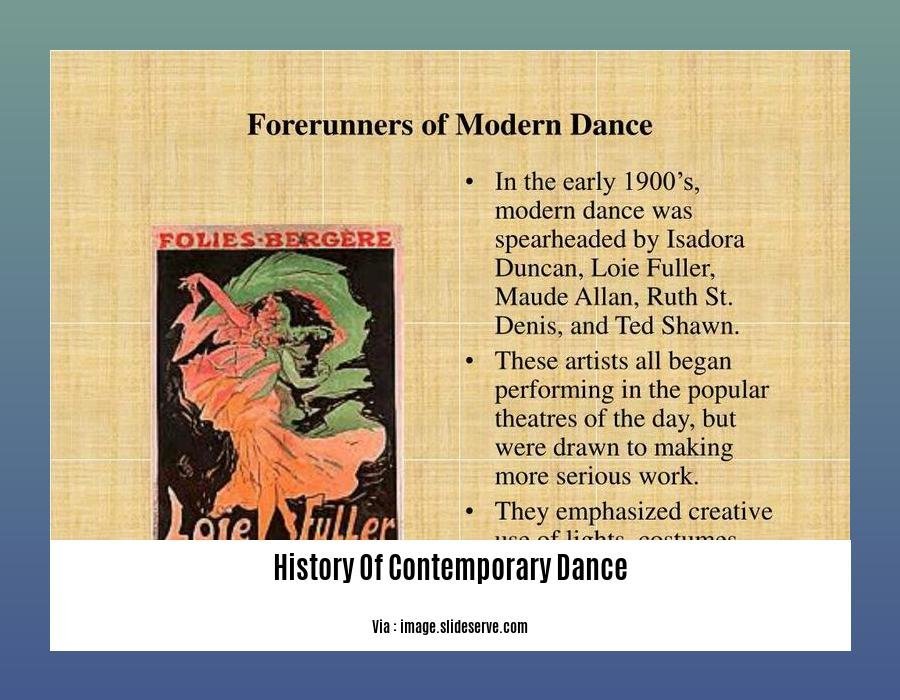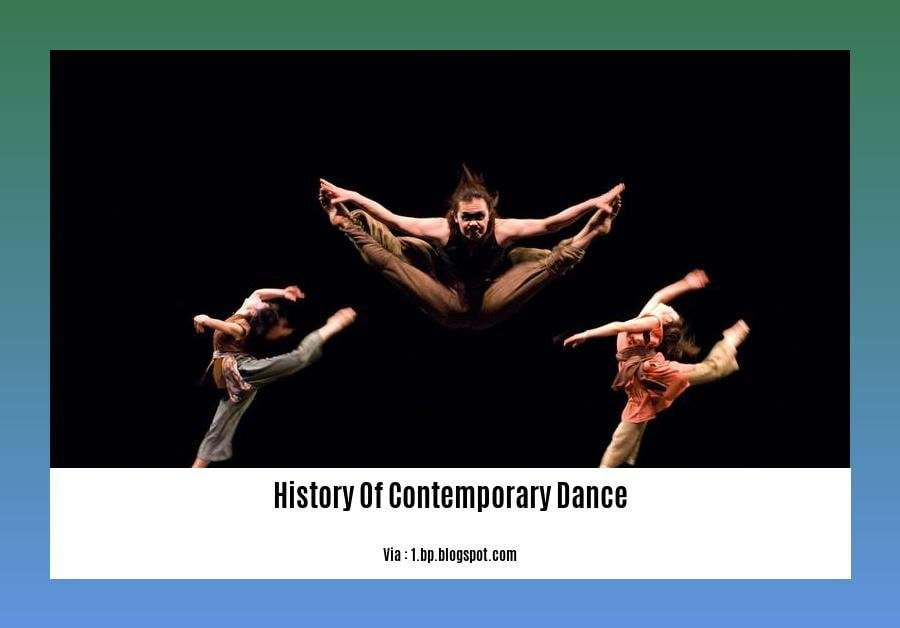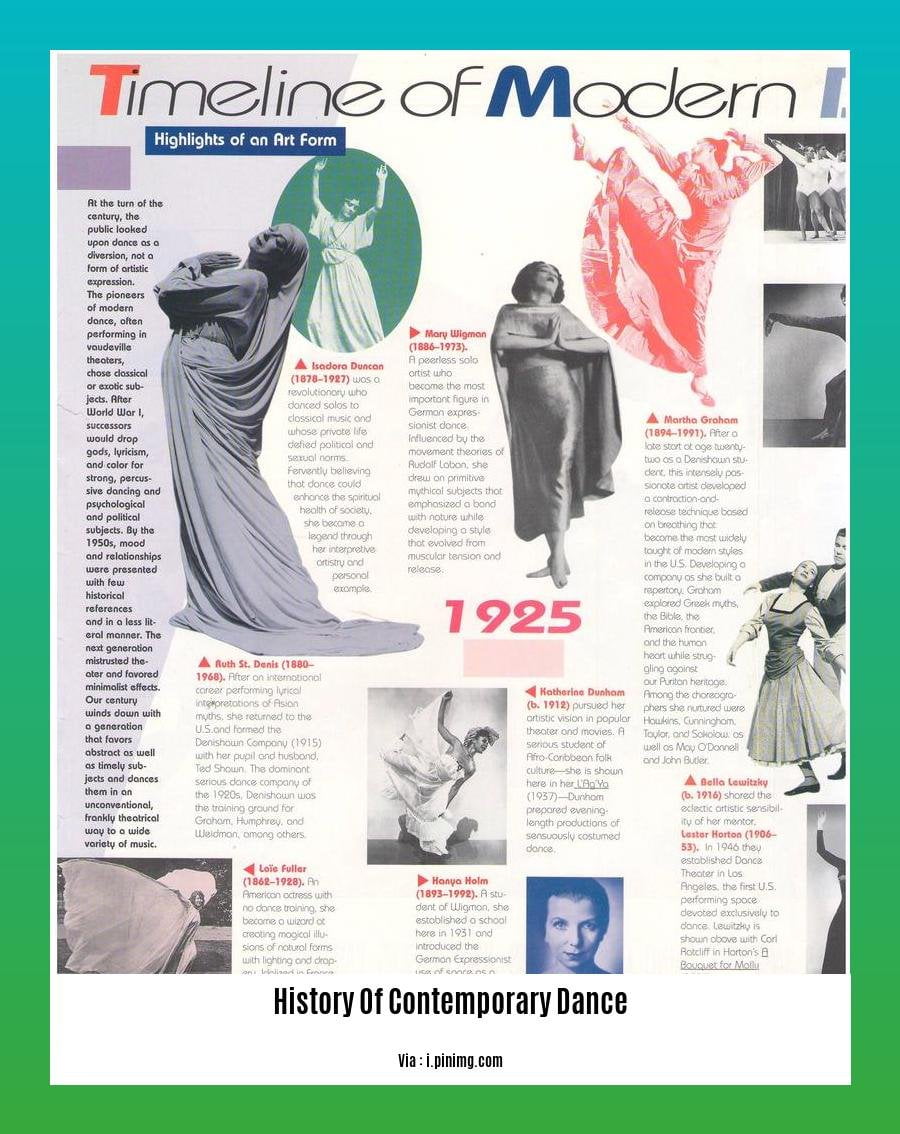Embark on an intriguing journey through time as we unravel the captivating history of contemporary dance in “Unraveling the Past: A Historian’s Perspective on the History of Contemporary Dance.” Delve into the origins, influences, and evolution of this dynamic art form, exploring its profound impact on the cultural landscape.
Key Takeaways:
Contemporary dance emerged during the mid-20th century as a reaction against classical ballet’s rigidity.
Isadora Duncan, an American dancer, was pivotal in shaping this movement with her natural and expressive style, pioneering a form of dance that questioned traditional ballet techniques and artistic approaches.
The innovations Duncan brought forth laid the foundation for a diverse array of contemporary dance forms, many of which have close connections to musical genres like jazz, rock and roll, and hip-hop.
History of Contemporary Dance

As a dance historian, I’ve delved deep into the evolution of contemporary dance, a genre that emerged as a rebellious force against the rigid structures of classical ballet. Its roots can be traced back to the mid-20th century, when dancers yearned for a style that allowed for more freedom and self-expression.
Pioneers of Contemporary Dance
At the forefront of this movement was Isadora Duncan, an American dancer who rejected the constricting techniques of ballet. She sought to create a natural and expressive style that celebrated the human form and intuition. Duncan’s innovations paved the way for a new era in dance, one that embraced individuality and broke free from traditional constraints.
Breaking the Mold
Duncan’s influence reverberated throughout the dance world, inspiring a generation of dancers to question established norms and explore new possibilities. The result was a multitude of contemporary dance forms, each with its own unique characteristics and influences. Some styles, like jazz, rock and roll, and hip-hop, found a close connection to specific musical genres, further expanding the boundaries of contemporary dance.
Contemporary Dance Today
In the present day, contemporary dance stands as a vibrant and diverse art form, encompassing a wide range of techniques, styles, and themes. It’s a testament to the pioneers who dared to challenge conventions and forge a new path for dance. Contemporary dance continues to evolve, drawing inspiration from various cultures, disciplines, and personal experiences, ensuring its enduring relevance and vitality.
For an extensive journey through the ages of construction innovation, dive into the history of concrete timeline to witness the evolution of the world’s most versatile building material.
Unlock the secrets of modern office technology by exploring the history of copiers, a journey that transformed the way we communicate and share information.
In the realm of office technology, discover the history of copy machines, a chronicle of innovation that revolutionized document reproduction and ushered in a new era of efficiency.
Postmodern Dance and Experimentation: Analyzing the emergence of postmodern dance, emphasizing experimental approaches to choreography and criticism.

In the realm of contemporary dance, the emergence of postmodernism marked a revolutionary shift, challenging conventions and embracing experimentation. This movement, which took root in the 1960s, sought to break free from the rigid structures of modern dance, paving the way for a more open and inclusive approach to choreography and criticism.
Origins and Pioneers of Postmodern Dance
The Judson Dance Theater in New York City served as a fertile ground for the development of postmodern dance, with influential figures like Merce Cunningham, Yvonne Rainer, and Trisha Brown leading the charge. Cunningham, often regarded as the father of postmodern dance, championed chance and the separation of dance from traditional narratives and music.
Key Characteristics of Postmodern Dance
Rejection of Traditional Norms: Postmodern dance rejected the established notions of form, technique, and narrative, embracing a more fluid and experimental approach.
Emphasis on Experimentation and Improvisation: Choreographers employed improvisation and chance procedures, allowing for a more spontaneous and unpredictable outcome.
Incorporation of Everyday Movements: Postmodern dance incorporated everyday movements and gestures, blurring the boundaries between dance and daily life.
Self-Referential and Ironic Qualities: Postmodern dance often questioned its own nature and relationship with the audience, employing irony and self-referential elements.
Collaboration and Interdisciplinary Work: Postmodern dance encouraged collaboration and interdisciplinary work, involving artists from diverse fields such as music, visual arts, and theater.
Key Takeaways:
Postmodern dance emerged as a reaction against the conventions of modern dance, emphasizing experimentation and improvisation.
Judson Dance Theater was a hub for postmodern dance, with influential choreographers like Merce Cunningham, Yvonne Rainer, and Trisha Brown leading the movement.
Postmodern dance rejected traditional notions of form, technique, and narrative, embracing chance and everyday movements.
Postmodern dance often employed self-referential and ironic qualities, questioning its own nature and relationship with the audience.
Collaboration and interdisciplinary work were encouraged in postmodern dance, fostering a more inclusive and experimental approach.
Sources:
- Postmodern dance pioneers, 60 years later
- Postmodern dance
Globalization and Cultural Exchange: Examining the global exchange of ideas and influences on contemporary dance, highlighting cross-cultural collaborations.
The world of dance, like many other art forms, is a tapestry woven with threads of cultural exchange and globalization. In the realm of contemporary dance, this exchange has been particularly pronounced, leading to a vibrant and diverse art form that continues to evolve.
Key Takeaways:
Globalization has facilitated the cross-pollination of ideas and influences in contemporary dance, leading to a rich tapestry of styles and techniques.
Cultural exchange has played a crucial role in shaping the evolution of contemporary dance, fostering cross-cultural collaborations that have pushed the boundaries of the art form.
Contemporary dance has become a truly global phenomenon, transcending national borders and creating a global community of dancers and choreographers.
International festivals, workshops, and collaborations have been instrumental in facilitating the exchange of ideas and fostering a sense of global interconnectedness within the contemporary dance community.
Cultural exchange in contemporary dance is a two-way street, with ideas and influences flowing in both directions, fostering mutual understanding and appreciation.
GLOBAL INTERCONNECTEDNESS: A CATALYST FOR CREATIVITY
In the interconnected world of today, contemporary dance has become a global phenomenon. Dancers and choreographers from different corners of the world come together to share ideas, collaborate on projects, and create works that reflect the diversity and richness of our globalized society.
CROSS-CULTURAL COLLABORATIONS: BREAKING BOUNDARIES
Cross-cultural collaborations are at the heart of the contemporary dance world. Choreographers and dancers from different cultural backgrounds bring their unique perspectives and experiences to the creative process, resulting in innovative and boundary-pushing works of art.
INSPIRATION FROM DIVERSE SOURCES
Contemporary dance draws inspiration from a wide range of sources, including traditional folk dances, modern dance techniques, and popular culture. This eclectic mix of influences contributes to the diversity and vitality of the art form.
GLOBAL FESTIVALS AND WORKSHOPS: PLATFORMS FOR EXCHANGE
International dance festivals and workshops provide platforms for dancers and choreographers to come together, share their work, and learn from each other. These events facilitate the exchange of ideas, techniques, and cultural perspectives, fostering a sense of global community.
A SHARED LANGUAGE OF MOVEMENT
Despite cultural differences, contemporary dancers and choreographers share a common language of movement. This shared language allows them to communicate and collaborate seamlessly, creating works that transcend national borders and cultural boundaries.
Sources:
The Globalization of Contemporary Dance: A Critical Examination of Cross-Cultural Collaborations
Cultural Exchange in Contemporary Dance: A Case Study of the Batsheva Dance Company
Contemporary Dance Innovations: Showcasing modern choreographers and companies pushing boundaries, exploring new technologies, and creating new aesthetic perspectives.
In the realm of contemporary dance, a vibrant tapestry of innovation unfolds, showcasing modern choreographers and companies who boldly push boundaries, explore uncharted territories, and redefine the very essence of the art form.
Martha Graham’s revolutionary techniques liberated dance from the constraints of classical ballet, introducing a new language of movement that celebrated the raw power and expressiveness of the human body.
Pina Bausch’s groundbreaking Tanztheater Wuppertal challenged conventional notions of dance, merging elements of theater, music, and visual art to create immersive, thought-provoking performances that left audiences spellbound.
Akram Khan’s boundary-defying fusion of contemporary dance with Kathak, a traditional Indian dance form, opened up new avenues of storytelling and cross-cultural dialogue.
Wayne McGregor’s innovative use of technology, including motion capture and digital projection, transformed the stage into a dynamic canvas, blurring the lines between the physical and the virtual.
Hofesh Shechter’s visceral, high-energy choreography captivated audiences with its raw emotionality and athleticism, pushing the boundaries of physical expression.
These visionary choreographers and companies are just a few examples of the many innovators who are shaping the future of contemporary dance. Through their unwavering commitment to experimentation, collaboration, and artistic excellence, they are expanding the possibilities of dance and creating unforgettable experiences that leave audiences inspired and transformed.
Key Takeaways:
Contemporary dance is a dynamic and ever-evolving art form, constantly pushing boundaries and exploring new possibilities.
Modern choreographers and companies are using technology, cross-cultural fusion, and innovative movement techniques to create groundbreaking performances.
These innovators are challenging traditional notions of dance and creating new aesthetic perspectives that captivate and inspire audiences worldwide.
Relevant URL Sources:
- The Pioneers of Postmodern Dance, 60 Years Later
- Postmodern dance
FAQ
Q1: What were the key factors that led to the emergence of contemporary dance in the mid-20th century?
Q2: Can you explain the role of Isadora Duncan in pioneering contemporary dance and how her innovations influenced the development of the art form?
Q3: How did the rejection of ballet’s strictures and conventions contribute to the development of contemporary dance in Britain and the United States?
Q4: What are some of the distinctive characteristics that differentiate contemporary dance from classical ballet, and how did these differences impact the evolution of dance?
Q5: In what ways have contemporary dance and its diverse range of styles been influenced by different music genres such as jazz, rock and roll, and hip-hop?
- China II Review: Delicious Food & Speedy Service - April 17, 2025
- Understand Virginia’s Flag: History & Debate - April 17, 2025
- Explore Long Island’s Map: Unique Regions & Insights - April 17, 2025

![[Phrase Match] Embracing Evolution: A Journey Through Contemporary Dance History contemporary-dance-history_2](https://www.lolaapp.com/wp-content/uploads/2023/12/contemporary-dance-history_2-150x150.jpg)














